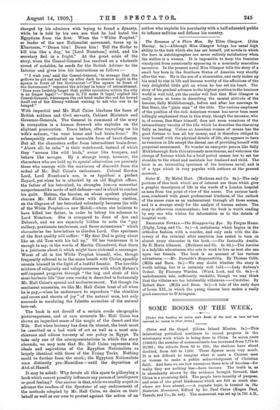SOME BOOKS OF THE WEEK.
[Under this heading ri notice such Books of the week as have not Won 'Inserted for review in other forms.]
China and the Gospel. (China Inland Mission. ls.)—This interesting periodical continues to record progress in the missionary work which is being done in China. In seven years (1902-8) tho number of communicants has increased from 7,774 to 20,993; the schools from 83 to 210; the stations have about doubled, from 500 to 1,000. These figures mean very much. It is not difficult to imagine what it costs a Chinese man or woman to make a public acknowledgment of Christian faith. And here we see how numerous these acts of heroism—for really they are nothing less—have become. The truth is, as is abundantly shown by the evidence brought forward, that China is a promising field. The people have tenacity of purpose, and some of the great hindrances which are felt so much else- where are here absent.7---A. cognate topic is treated in The Nestorian Monument, Edited by Dr. Paul Carus (Regan Paul, Trench, and Co., 2s. net). The monument was set up in 781 A.D., and recorded the early successes of Christian missions as carried on by Nestorian evangelists for about a century and a half before this date. The first leader was a Syrian of the name of Olopun. The Emperor of the time was Tel- tsung. He is said to have examined the new doctrine, and, "becoming deeply impressed with its rectitude and truth, to have given special orders for its dissemination." The after history of the Mission is obscure ; but it certainly disappeared without leaving any trace beyond this massive monument, with its inscription. (It is ten feet high, and its weight is calculated at two tons.) It became known to European travellers in 1625, and the inscription in somewhat difficult Chinese has been often translated. A Danish traveller, M. Fritz V. Holm, endeavoured to secure the stone; finding this impossible, he caused a facsimile to be made, and got this transported, with a very considerable expenditure of labour, to Hankow. Curiously enough, the chief trouble began here. An over-zealous English clerk in the Customs caused it to be impounded. Sir Robert Hart, however, intervened, and the stone was shipped for New York. It is possible that the clerk supposed it to be an original which ought not to be allowed to leave the cpuntry. Nestorius has lately been rehabilitated. He was logically wrong, it may be said, when he objected to the term Theotelcos. But we must credit him with an early protest against what is really a serious heresy. His error was an error in terms. That which is implied in the motto, Tout a Jesus par Marie, touches the essence of Christian truth.







































 Previous page
Previous page